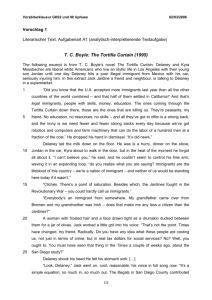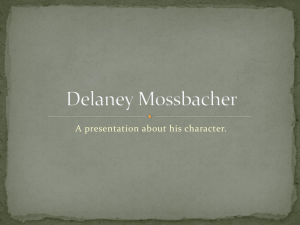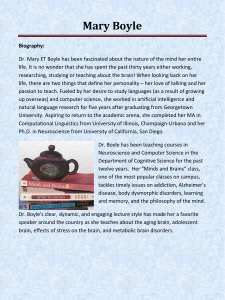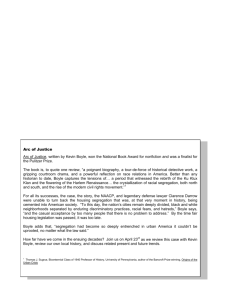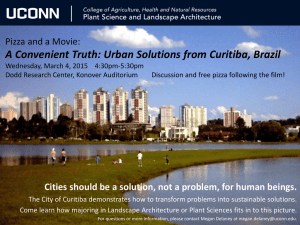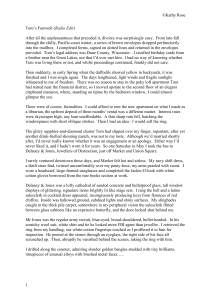Discussion Guide
advertisement
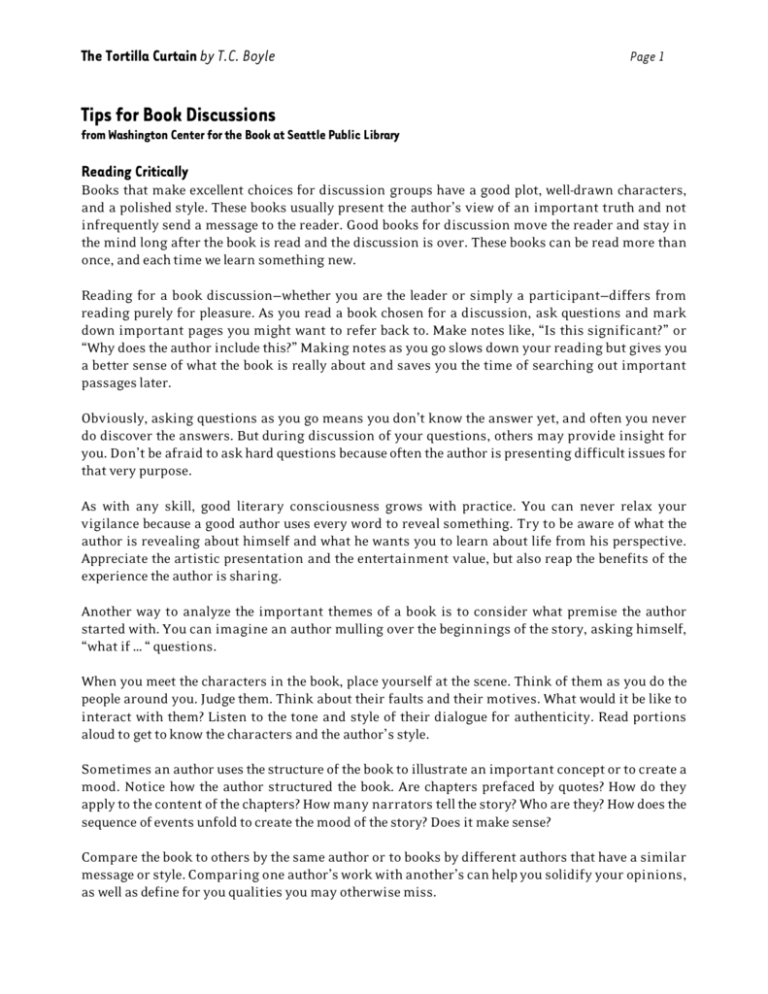
The Tortilla Curtain by T.C. Boyle Page 1 Tips for Book Discussions from Washington Center for the Book at Seattle Public Library Reading Critically Books that make excellent choices for discussion groups have a good plot, well-drawn characters, and a polished style. These books usually present the author’s view of an important truth and not infrequently send a message to the reader. Good books for discussion move the reader and stay in the mind long after the book is read and the discussion is over. These books can be read more than once, and each time we learn something new. Reading for a book discussion—whether you are the leader or simply a participant—differs from reading purely for pleasure. As you read a book chosen for a discussion, ask questions and mark down important pages you might want to refer back to. Make notes like, “Is this significant?” or “Why does the author include this?” Making notes as you go slows down your reading but gives you a better sense of what the book is really about and saves you the time of searching out important passages later. Obviously, asking questions as you go means you don’t know the answer yet, and often you never do discover the answers. But during discussion of your questions, others may provide insight for you. Don’t be afraid to ask hard questions because often the author is presenting difficult issues for that very purpose. As with any skill, good literary consciousness grows with practice. You can never relax your vigilance because a good author uses every word to reveal something. Try to be aware of what the author is revealing about himself and what he wants you to learn about life from his perspective. Appreciate the artistic presentation and the entertainment value, but also reap the benefits of the experience the author is sharing. Another way to analyze the important themes of a book is to consider what premise the author started with. You can imagine an author mulling over the beginnings of the story, asking himself, “what if … “ questions. When you meet the characters in the book, place yourself at the scene. Think of them as you do the people around you. Judge them. Think about their faults and their motives. What would it be like to interact with them? Listen to the tone and style of their dialogue for authenticity. Read portions aloud to get to know the characters and the author’s style. Sometimes an author uses the structure of the book to illustrate an important concept or to create a mood. Notice how the author structured the book. Are chapters prefaced by quotes? How do they apply to the content of the chapters? How many narrators tell the story? Who are they? How does the sequence of events unfold to create the mood of the story? Does it make sense? Compare the book to others by the same author or to books by different authors that have a similar message or style. Comparing one author’s work with another’s can help you solidify your opinions, as well as define for you qualities you may otherwise miss. The Tortilla Curtain by T.C. Boyle Page 2 The very best books are those that insinuate themselves into your experience: They reveal an important truth or provide a profound sense of kinship between reader and writer. Searching for, identifying, and discussing these truths often make the book more important and more significant. Asking questions, reading carefully, imagining yourself into the story, analyzing style and structure, and searching for personal meaning in a work of literature all enhance the work’s value and the discussion potential for your group. The Discussion Come prepared with 10 to 15 open-ended questions. Questions that can be answered yes or no tend to cut off discussion. Questions should be used to guide the discussion and keep it on track, but be ready to let the discussion flow naturally. You’ll often find that the questions you’ve prepared will come up naturally as part of the discussion. Remind participants that there are not necessarily any right answers to the questions posed. Don’t be afraid to criticize a book, but try to get the group to go beyond the “It just didn’t appeal to me” statement. What was it about the book that made it unappealing? The style? The pacing? The characters? Has the author written other books that were better? Did it remind you of a book that you liked/disliked? Many times the best discussions are about books that the majority of the group disliked. Try to keep a balance in the discussion between personal revelations and reactions and a response to the book itself. Every reader responds to a book in ways that are intimately tied to his/her background, upbringing, and world view. A book about a senseless murder will naturally strike some sort of chord in a reader whose mother was murdered. That’s interesting, but what’s more interesting is how the author chose to present the murder, or the author’s attitude toward the murderer and victim. It’s often too easy to let a group drown in reminiscences … if that’s what the whole group wants to do, that’s fine, but keep in mind that it’s not a book discussion. The Tortilla Curtain by T.C. Boyle Page 3 About the Author (from Carlsbad City Library, CA, “Carlsbad Reads Together” resource guide) T. Coraghessan Boyle, “my friends call me Tom,” was born December 2, 1948 and grew up in Peekskill, New York. He went to the State University of New York at Potsdam to study music (he played the saxophone), switched to a History and English major and found himself drawn to writing after “wandering into a creative writing class in his junior year.” For four years, he taught at his alma mater, Lakeland High School, until his story, “The OD and Hepatitis Railroad or Bust,” was published in the North American Review. He won acceptance at the University of Iowa Writer’s Workshop in 1972. He received his M.F.A. in 1974 and his Ph.D. in 19th Century British Literature in 1977 from the University of Iowa. In 1977 he received a grant from the National Endowment for the Arts. He has been an English professor at University of Southern California since 1978, and established their Creative Writing Program. He has written sixteen books and won the PEN/Faulkner Award for “T.C. Boyle Stories, the Collected Stories” in 1999; for best novel in 1988 for “World’s End”; O. Henry Awards in 1989, 1999, 2001 and 2003; was a National Book Award Finalist for “Drop City” in 2003; awarded the Prix Medicis Etranger (Paris) for the best foreign novel of the year in 1997 for “The Tortilla Curtain”; and received the New York Times Book Review Editors’ Choice 1989 for “If the River Was Whiskey.” His latest books are “Inner Circle” (2004), “Tooth and Claw” (2005) and “Talk Talk” (July 2006).” The book “Tortilla Curtain” is currently being made into a movie. He lives in Montecito, a suburb outside of Santa Barbara, with his wife and three children and still teaches when he can at University of Southern California. T.C. Boyle is a writer who believes literature should be accessible to all without needing a reviewer or critic to help explain the mechanics of the story. He is a storyteller with immense compassion, and a wise guy who is known for his satire and his ability to confront hypocrisy. Official Web site: www.tcboyle.com. The Tortilla Curtain by T.C. Boyle Page 4 Other Titles by T.C. Boyle Descent of Man (Atlantic-Little, Brown, 1979) Water Music (Atlantic-Little, Brown, 1982) Budding Prospects (Viking, 1984. Greasy Lake (Viking, 1985) World’s End (Viking, 1987) If the River Was Whiskey (Viking, 1989) East Is East (Viking, 1990) The Road to Wellville (Viking, 1993) Without A Hero (Viking, 1994) Riven Rock (Viking, 1998) T.C. Boyle Stories (Viking, 1998) A Friend of the Earth (Viking, 2000) After the Plague (Viking, 2001) Drop City (Viking, 2003) The Inner Circle (Viking, 2004) Tooth and Claw (Viking, 2005) Talk Talk (Viking, July 2006) Reviews of “The Tortilla Curtain” (from Carlsbad City Library, CA, “Carlsbad Reads Together” resource guide) Amidon, Stephen. “Why There’s No More Dreamin’ for California’s Chardonnay Socialists,” Esquire, November 1995. Finkel, Anita. “The Tortilla Curtain: Voltaire in an L.A. Canyon,” Baltimore Sun, Sept. 17, 1995 (available on www.tcboyle.com). Kingsolver, Barbara. “Downscale in Topanga Canyon,” Nation, September 25, 1995. Sipchen, Bob. “The Wise Guy: No One Escapes the Sting of Writer T. Coraghessan Boyle’s Satire,” Los Angeles Times, Aug. 20, 1995 (Life and Art Section). Stephens, Maura. “To Live and Cry in L.A.,” Newsweek, October 9, 1995 (available on www.tcboyle.com). The Tortilla Curtain by T.C. Boyle Page 5 About the Book From a reading group guide on http://us.penguingroup.com/ Courtesy of Penguin Putnam, Inc. In this explosive and timely novel, T. Coraghessan Boyle explores an issue that is at the forefront of our political arena. He confronts the controversy over illegal immigration head-on, illuminating the people on both sides of the issue, the haves and the have-nots, through a poignant, gripping story. In Southern California’s Topanga Canyon, two couples live in close proximity and yet are worlds apart. High atop a hill overlooking the canyon, nature writer Delaney Mossbacher and his wife, real estate agent Kyra Menaker-Mossbacher, reside in an exclusive, secluded housing development with her son, Jordan. The Mossbachers are agnostic liberals with a passion for recycling and fitness. Camped out in a ravine at the bottom of the canyon are Cándido and América Rincón, a Mexican couple who have crossed the border illegally. On the edge of starvation, they search desperately for work in the hope of moving into an apartment before their baby is born. They cling to their vision of the American dream, which, no matter how hard they try, manages to elude their grasp at every turn. A violent chance encounter brings together Delaney and Cándido, beginning a chain of events that culminates in a harrowing confrontation. The novel shifts back and forth between the two couples, giving voice to each of the four main characters as their their worlds collide and their lives become inextricably intertwined. The Rincóns’ search for the American dream, and the Mossbachers’ attempts to protect it, comprise the heart of the story. In scenes that are alternately comic, frightening and satirical, but always all too real, Boyle confronts not only immigration but social consciousness, environmental awareness, crime and unemployment in a tale that raises the curtain on the dark side of the American dream. The Tortilla Curtain by T.C. Boyle Page 6 Discussion Questions From NoveList/EBSCO Publishing © 2001 (Get to NoveList from the library’s Web site: http://www.dbrl.org/reference/databases.html) While answers are provided, there is no presumption that you have been given the last word. Readers bring their own personalities to the books that they are examining. What is obvious and compelling to one reader may be invisible to the next. The questions that have been selected provide one reasonable access to the text; the answers are intended to give you examples of what a reflective reader might think. The variety of possible answers is one of the reasons we find book discussions such a rewarding activity. Page numbers refer to the Penguin paperback edition. Why are boundaries so important in the novel? Every piece of property, every social interaction, every public space in the story’s California landscape is carefully marked off and delimited, broken into small individual spaces. To the residents of Arroyo Blanco, these boundaries almost limit the individual’s very sense of self. When Kyra loses her dog Sacheverell to the coyote, she takes the animal’s attack as a highly personal invasion of the sanctity of her space. Losing the dog is terrible, of course, but it becomes far worse when it happens within the fenced-in boundary of the Mossbacher backyard. The violation of these boundaries (their home, state parks, Delaney’s car) terrifies Delaney and Kyra because each intrusion breaks down the firm boundaries of their private world. The idea of property permeates the novel. It concerns the residents of Arroyo Blanco, it haunts the dreams of Cándido and América, and it is Kyra’s livelihood. Property symbolizes more than just a parcel of land, of course; it is a private domain, a personal and private refuge, and it is for this reason that trespassing (both by humans and animals) takes on such an importance. The coyote attacks, the graffiti on the Da Ros house, and the sleeping bags Delaney finds in the canyon all disturb the Mossbachers deeply. They (and their friends) continue to retreat from the urban environment of Los Angeles, searching for a place free from intrusions into their property, a place that they can own without fear (and without sharing), but their attempts to create such a space in Arroyo Blanco are continually frustrated. Neither animals nor humans will leave them their exclusive, private spaces in the hills. All of the smaller lines of demarcation are ultimately just instances of the largest boundary in the book: the Mexican-American border. This border, and specifically the California section of it, lends the book its title, and is a central issue of contention in the story. As Jack Jardine tells Delaney, “This society isn’t what it was -- and it won’t be until we get control of the borders” (p. 101). Although Delaney responds, “That’s racist, Jack, and you know it,” it doesn’t take long for him to come around to the same viewpoint. The events playing out in Arroyo Blanco mirror the larger debates over immigration and illegal aliens that occupy the minds of Californians The phrase “The Tortilla Curtain” brings to mind a comparison with the Iron Curtain; they aren’t the same, of course, but both are dedicated to keeping certain people on certain sides of a rather arbitrary line. The Communist regimes of Eastern Europe were often criticized for the rigor with The Tortilla Curtain by T.C. Boyle Page 7 which they kept their own citizens from crossing their national borders. In modern America, the same sort of rigor is employed in keeping illegal immigrants out, and Boyle questions the wisdom of this policy. Ultimately, boundaries divide people and things from one another. Boyle does not hold up a strong alternative to this depth of segmentation he sees in American society, but he does do a powerful job of showing its danger and ultimate futility. Do the walls and gates around Arroyo Blanco work? In some ways the boundaries around Arroyo Blanco help to keep out “undesirable” outside elements–snakes and such–but for the most part they function only to illustrate the futility of the attempt to detach oneself from the life of the surrounding community and the limits of the boundaries that humans can impose on the natural world. The Mossbachers have a gated yard from the beginning of the story, but it doesn’t prevent the loss of Sacheverell to the coyote. So they raise the wall height two feet, believing that no coyote could leap eight feet of chain link fence. They’re right–coyotes cannot jump that high–but the coyote finds a way over the new fence again to snatch Kyra’s second dog. The gates also cannot keep crime at bay. Burglaries persist after the gate goes up as the criminals, like the coyotes, simply adapt their tactics to the new situation. The novel doesn’t tell us whether the new wall proves any more effective at safeguarding the community, but the implied answer is that it cannot. But Boyle’s point about such boundaries extends beyond the practical questions of whether such devices will work well or not. Even if the walls and locks and gates are one hundred percent effective, he appears to ask, is the resulting separation of culture and class and wealth such a good thing, even to the rich folks on the inside of the wall? His answer is an unqualified no, because a wall doesn’t simply keep things out, it also lock things inside. Living within an insulated community can easily breed vices of its own. No better example of this exists in the book than Jack Jr, son of the prime mover behind the new wall. Jack Jardine senior wants the wall up to keep out the likes of taggers and vandals, but it turns out that his son is one of them. The isolated environment of Arroyo Blanco Estates, white (as the name itself subtly indicates) and wealthy, does not always insure liberal values and good breeding, but provides a perfect breeding ground for racial snobbery and the violence of the spoiled. Delaney overhears Jack Jr. making racial slurs and realizes this truth about walls, “it might keep them out, but look what it keeps in. It was poisonous. The whole place was poisonous, the whole state” (p. 224). In the ultimate irony, the wall’s purpose of keeping criminals at bay could never have succeeded because Arroyo Blanco already had its own criminals, the most visible of which was Dominic Flood. Jack Jardine’s concern at keeping crime out of the community begins to look merely racist when he not only accepts but befriends a convicted criminal under house arrest. Since Flood could host lavish parties and generous cocktail hours, he couldn’t be a real criminal, right? All the walls and gates in the world can never keep Arroyo Blanco untouched and isolated because the pressures of the environment will adapt their means and ways to push back on the development that tries so hard to exclude them. And the people inside are not without problems, prejudices, and sins of their own, despite being wealthy. The Tortilla Curtain by T.C. Boyle Page 8 Why does Delaney’s nature writing come to focus mainly on the coyote? Though Delaney himself never makes the connection, his writing about animals and the natural world relates directly to the very human problems of race and immigration that he deals with on a daily basis. The coyote, especially, provides a wonderful symbol for what will happen when humans attempt to exert too much control over the natural world. Developments like Arroyo Blanco push further into the wild countryside but try to maintain a pristine and highly regulated environment within the boundaries they erect, keeping the newly displaced predators and animal life of the chaparral at bay. As Delaney makes clear in one of his magazine columns, such an approach is nothing less than dangerous, for the coyote is infinitely adaptable and able to overcome the fences and walls put up to contain it. Coyotes will make it inside the walls to snatch dogs, or a drink, or even a child. “We cannot eradicate the coyote,” Delaney writes, “nor can we fence him out, not even with eight feet of chain link, as this sadder but wiser pilgrim can attest. Respect him as the wild predator he is, keep your children and pets inside, leave no food source, however negligible, where he can access it” (p. 214). Everything that Delaney writes about the coyote applies equally well to the problem of immigrants and “The Tortilla Curtain.” These elite subdivisions, which have walled themselves off from the rest of the world and fail to live in harmony with it, will not escape either the coyote or the immigrant, for both are adaptable, and both are hungry. Delaney concludes his column, “The coyotes keep coming, breeding up to fill in the gaps, moving in where the living is easy. They are cunning, versatile, hungry and unstoppable” (p. 215). This could easily sum up the view of Arroyo Blanco’s residents toward Mexicans. We can watch Delaney’s attitude toward Mexicans change throughout the book as he unconsciously reflects it in his nature writing. Initially a staunch defender of the coyote and of the idea of living in harmony with the rhythms of the natural world, he comes to believe that “some sort of control must be applied” (p. 212). When a species is pushed out of its original habitat, it often pushes back as its tries to adapt to the new situation. Most of the whites in the story seem to feel that the Mexicans are invading and overwhelming them, encroaching on their own territory, and that a backlash is an appropriate response. But the book raises the question of which group is truly the invader; California originally belonged to Mexico, of course, and the US basically took it by force. Which group is the invader, and which group is being pushed back? Delaney does not explore these questions directly, but his columns and reflections on nature allow him to think through the issues involved, and give us an important glimpse into his changing modes of thought as he gradually sheds his liberal humanist views for more explicitly racist and angry ones. Delaney, for all his liberal credentials, holds a fair number of stereotypes about immigrants, especially Mexicans. Does he find his views overturned or reinforced over the course of the book? Delaney believes himself to be free of ignorant prejudices until he sees them gradually emerge in his own mind. His accident with Cándido, for example, is a perfect example. He always believes that the collision was Cándido’s fault, and that he had thrown himself in front of the car in a deliberate attempt to collect insurance money. When Cándido finds himself able to mouth only one English word, “Money?”, Delaney merely confirms his internal assumption and hands Cándido twenty The Tortilla Curtain by T.C. Boyle Page 9 dollars. He never seems to wonder how twenty dollars could possibly be adequate compensation for a painful and traumatic accident, much less why anyone would do such a thing deliberately for such little money. He has read about such things in the papers, and when he collides with Cándido, a Mexican, the assumption comes automatically. And when his car is stolen, Delaney believes that the vehicle is already in Mexico, though he never gains any evidence about the thieves. As the stressful situations mount in his life, Delaney’s prejudices gradually leak out into his mind and consume his life. Part of Boyle’s narrative artistry lies in the way he refuses to make the issue of stereotypes simple. It would be all too easy for a book such as “The Tortilla Curtain” to highlight the ignorant prejudices of a wealthy nature writer, to show how out of touch his views are with reality. But Boyle resists this temptation; Delaney’s experiences in the book work both to confirm and to break down his stereotypes of Mexican immigrants. For instance, Kyra’s encounter with the two men at the DA Ros property and the subsequent Spanish graffiti that she finds sprayed on the wall confirm Delaney’s latent prejudices. Finding Cándido and América’s camp in the ravine, litter strewn across the ground, confirms another of his beliefs. And finding them squatting near his property in a small makeshift house of stolen materials is the final straw for him. There are also events that should shake up his views a bit, though they have little effect. When he finds a Mexican in Arroyo Blanco, he assumes that the man is casing the empty houses for future theft attempts. He is positively startled to find out that the man really has legitimate business in the neighborhood (p. 228). The graffiti on Arroyo Blanco’s front gate that he assumes to be the work of Mexican taggers turns out to be the work of Jack Jr. Even with the photographic proof before his eyes, however, he cannot release his rage toward Cándido and Mexicans in general. We have no chance to gauge the result of the book’s final, touching gesture: Cándido’s hand reaching down to grasp Delaney’s upraised arm in the water. After all that Cándido and his wife have suffered, much of it at the very hands of Delaney and Kyra, there is a common humanity binding them together, one that Cándido responds to out of instinct. What this gesture does to the Mossbachers we will never know, but it remains as the single most powerful symbol in the book of the common nature that we all share. Whether it will affect Delaney remains an open question. Regardless, it helps to bring the book full circle, reminding us of the book’s opening pages, but with a twist. Cándido is here the one in control, the one who can offer help to Delaney, who cannot speak his language. The irony of the situation is delicious. Does the “American dream” come true for Cándido and the other men from his hometown or are they ultimately disappointed? For Cándido, the answer isn’t hard to discover; the American dream of hard work and success never begins to materialize for him and América. He cannot even get the difficult and low-paying work that he so badly wants to support his small family, and his experiences in America read like a long litany of disasters. Over the entire course of the book, he does not spend a single night under a regular roof or in a bed. But the broader question of whether illegal Mexican immigrants find a better situation in the US is a more interesting and ambiguous one. Cándido is only one of many men from his village who head north every year for nine months or more to work the circuit of migrant labor in Idaho and California. Working mainly on farms or in construction, the men make little by American The Tortilla Curtain by T.C. Boyle Page 10 standards, but to many of them it seems like wealth. The money they earn allows them to send cash back to wives, children, and family members in Mexico and to live well when they return to their villages for the winter months. Boyle mentions the high unemployment rate in Mexico (40%) and the lack of opportunity as reasons for their decision to endure the difficulties of nine months in America, braving racism, low pay, and the perils of La Migra (Immigration). Is this truly a better way to live? The novel doesn’t provide an answer, but it does remind us of the number of people willing to try their luck in the United States, legally or otherwise. In one sense, though, the traditional American dream of hard work that leads to success will never be possible for the illegals. They will continue to be taken advantage of, paid little, and fail to advance because of their immigration status, which prevents them from being offered real employment at reputable companies. In this way, Boyle reminds us several times, things have changed in America since the days of the earliest settlers who came, worked hard, and established themselves in the land. As Delaney reminds Jack Jardine, the entire country is a nation of immigrants, no matter how far back one can traces one’s ancestry. But that pure form of the American dream can only be attained now with a green card or visa, and both are in limited supply. How does the story of Cándido and América parallel the story of the Joads in “The Grapes of Wrath”? Why? Boyle’s epigraph for the novel immediately clues us in to the fact that we should expect some type of parallel with “The Grapes of Wrath.” It comes directly from John Steinbeck’s book: “They ain’t human. A human being wouldn’t live like they do. A human being couldn’t stand it to be so dirty and miserable.” Reading “The Tortilla Curtain” with “The Grapes of Wrath” in mind adds a new depth to the story and raises some interesting questions about American attitudes toward the poor that transcend problems of illegal immigration. Steinbeck’s powerful novel about the Depression-era Joad family centers on their desperate and illfated trip to California in search of work and a better life. They are a family of bankrupt “Okies,” farmers from the drought-ridden plains of Oklahoma and central America, forced to leave their only source of livelihood to search for a new way to live. Unlike Cándido and América, the Joad family members are all legal citizens, but this doesn’t prevent them from enduring the same sets of problems and horrors in California. There are the same filthy living conditions, back-breaking migrant labor, cheating bosses, and attitudes of the rich that will confront the Rincóns seventy years later. Even the endings of the two stories echo one another, both involving California floodwaters and natural catastrophe. In a way, the Rincóns have become the Joads of modern American life. They are the “Okies,” the dispossessed, the poor, who seek out a better life for themselves by moving to the abundance of California (whether wanted or not). Comparing “The Tortilla Curtain” with “The Grapes of Wrath” shows us that the problem cannot be merely one of immigration status. The Joads, legal and upright white citizens, encounter the same prejudices and difficulties as the illegal immigrants Cándido and América. The “problem” of the Joads and the Rincóns is the same one; neither are “problems” because of their race, but because of their class. Or to be more precise, their wealth (and lack of it). One of the concerns that Boyle shares with Steinbeck is highlighting the ways that poverty is considered a moral failure in American life. Poverty is not simply an economic condition, but a vice, and the citizens of Arroyo Blanco shun it entirely. They are made as uncomfortable by the sight of poverty as they are by gangbangers, and want to keep both out of The Tortilla Curtain by T.C. Boyle Page 11 their lives. “The Tortilla Curtain” reminds us that poverty does not indicate moral turpitude or laziness, but that powerful social and political structures, designed by the wealthy, often keep the poor from advancing financially. The residents of Arroyo Blanco would rather block out the problem than deal with it, blaming and stereotyping those who may simply be victims, just as their counterparts did to the Joads many years before. Why do the whites so often make use of the same illegal Mexican immigrants that they fear and hate? One of the great tragicomic ironies of the novel is that Mexican labor (much of it presumably illegal) drives the great construction projects of the white residents fleeing the immigrant presence in the cities around them. Arroyo Blanco is no exception, either, and the irony becomes more pungent because of the fact that the walls and gates erected around the development are designed to keep out the very people who build them. The reason for all this isn’t especially difficult to pinpoint. Boyle clearly indicts the greed of the wealthy, the stinginess of those who actually have money, in employing illegal workers at illegal wages to perform difficult work for them. And by not inquiring too closely into the details of the work crews, the residents do not even need to feel guilty. Illegal immigrants obviously lack minimum wage protections, and so the jobs that both Cándido and América work range from $3-5 per hour for difficult work. The economics of such a situation are clear: if a contractor employs illegals, no taxes need to be paid, no benefits given, and no minimum wage offered. This lets the contractor offer a low bid to a development like Arroyo Blanco, full of wealthy people worried about any potential rise in their assessment. Neither Kyra nor Delaney seem bothered by the situation, even when they see these workers laboring at the gate or building a wall in their own backyard. Kyra even helps to have a group of Mexicans cleared out of parking lot where they wait for work in the mornings because of her fear that it will detrimentally affect her real estate business. Many of the very workers who put in the wall that she lobbies for so furiously are men drawn from such places, but she does not even make this connection when she calls Mike Bender to see what he can do. For further discussion: Read Joe Sedey’s comments, “Did the Chinese have a unique immigrant experience?” in the discussion guide for “The Joy Luck Club.” What do the Rincón’s experiences have in common with those of immigrants from Europe and Asia? How are they different? October, 2001 This book discussion guide was developed by Nathan Anderson, a doctoral student in English literature at the University of North Carolina-Chapel Hill. The Tortilla Curtain by T.C. Boyle Page 12 Further Reading Recommended by NoveList (See information preceding discussion questions.) Zadie Smith. White Teeth. (2000) A strong debut novel about the immigrant experience in Britain. Smith’s book spans time zones and countries, but focuses on a set of multicultural marriages made in a dilapidated suburb of northern London, where two families must confront their pasts and their new present in a changing world and struggle to make sense of it all. Gabriel Garcia Marquez. Chronicle of a Death Foretold. (1982) Marquez tells another tale of the Caribbean, this time set on an island that experiences its own racial troubles. Most intriguing is that we know from the book’s first sentence who will die; the story moves to its inexorable conclusion under the skilled hands of Marquez, who spins another fine story. John Steinbeck. The Grapes of Wrath. (1939) An American classic, Steinbeck’s story describes the Joad family’s flight from their wasted farm to California in search of jobs and a better life during the Great Depression. Russell Banks. Cloudsplitter. (1998) A long and fascinating novel about John Brown and his infamous raid on Harper’s Ferry, this is Banks at his best, probing the psychology of Brown and his children and race relations in nineteenth century America. He explores the basic paradox of Brown’s life, “How could a man believe it was right to kill others for owning slaves?”
